Essex Entries in the Common Pleas (1558)
The Common Roll of the Common Pleas records litigation before the justices de Banco from throughout England.
BOGGS. Cost: £8.00.  | Sample scan, click to enlarge
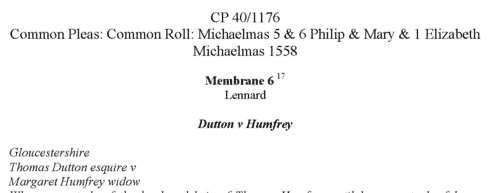
|
 Masters and Apprentices
(1718) Masters and Apprentices
(1718)
Apprenticeship indentures and clerks' articles were subject to a 6d or 12d per pound stamp duty: the registers of the payments usually give the master's trade, address, and occupation, and the apprentice's father's name and address, as well as details of the date and length of the apprenticeship. BOGGS. Cost: £8.00.  | Sample scan, click to enlarge

|
Delaware Militia (1777)
Muster rolls of the Delaware state militia.
BOGGS. Cost: £8.00.  | Sample scan, click to enlarge
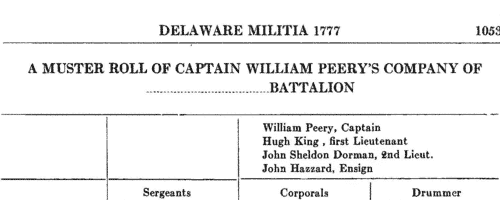
|
Shareholders of the Liverpool Union Bank
(1838)
The provincial banks of England and Wales made annual returns to the Stamp Office of their proprietors or shareholders. These returns, registered in March 1838, from the 103 banks then in existence, contain the full names and addresses of nearly 30,000 shareholders.BOGGS. Cost: £6.00.  | Sample scan, click to enlarge
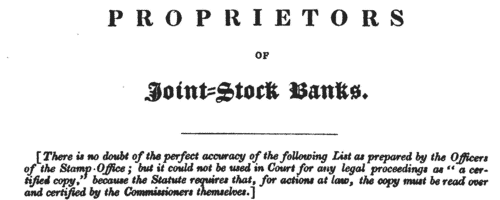
|
Shareholders of the South Lancashire Bank
(1838)
The provincial banks of England and Wales made annual returns to the Stamp Office of their proprietors or shareholders. These returns, registered in March 1838, from the 103 banks then in existence, contain the full names and addresses of nearly 30,000 shareholders.BOGGS. Cost: £6.00.  | Sample scan, click to enlarge
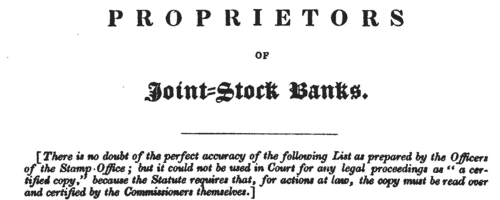
|
 British merchant seamen
(1835-1840) British merchant seamen
(1835-1840)
At this period, the foreign trade of ships plying to and from the British isles involved about 150,000 men on 15,000 ships; and the coasting trade about a quarter as many more. A large proportion of the seamen on these ships were British subjects, and so liable to be pressed for service in the Royal Navy; but there was no general register by which to identify them, so in 1835 parliament passed a Merchant Seamen's Registration Bill. Under this act a large register of British seamen was compiled, based on ships' crew lists gathered in British and Irish ports, and passed up to the registry in London. A parliamentary committee decided that the system devised did not answer the original problem, and the original register was abandoned after less than two years: the system was then restarted in this form, with a systematic attempt to attribute the seamen's (ticket) numbers, and to record successive voyages. The register records the number assigned to each man; his name; age; birthplace; quality (S = seaman, &c.); and the name and official number of his ship, with the date of the crew list (usually at the end of a voyage). Most of the men recorded were born in the British Isles, but not all. The system was still very cumbersome, because the names were amassed merely under the first two letters of surname; an attempt was made to separate out namesakes by giving the first instance of a name (a), the second (b), and so on. During 1840 this series of ledgers was abandoned, and a new set started with names grouped together by surname. BT 112/7BOGGS. Cost: £8.00.  | Sample scan, click to enlarge

|
Bankrupts
(1842)
Bankruptcy notices for England and Wales: bankruptcy often caused people to restart their lives elsewhere, so these are an important source for lost links
BOGGS. Cost: £6.00.  | Sample scan, click to enlarge

|
Dividends of bankrupts' estates
(1842)
Dividends from moneys raised from bankrupts' estates in England and WalesBOGGS. Cost: £6.00.  | Sample scan, click to enlarge

|
Bankruptcy meetings
(1843)
Meetings for the allowance of bankrupts' certificates in England and Wales: a final stage before the discharge of a bankruptBOGGS. Cost: £6.00.  | Sample scan, click to enlarge

|
Bankruptcy Meetings
(1843)
Meetings about bankrupts' estates in England and WalesBOGGS. Cost: £6.00.  | Sample scan, click to enlarge
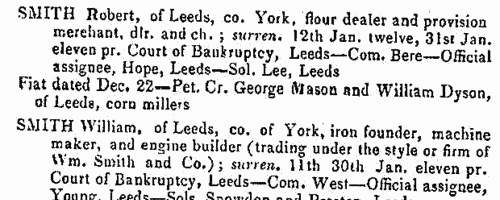
|
Research your ancestry, family history, genealogy and one-name study by direct access to original records and archives indexed by surname.













